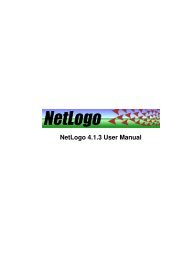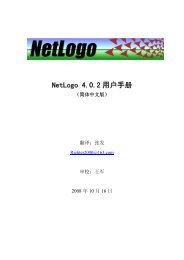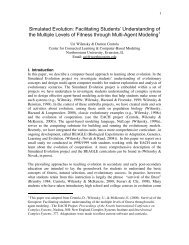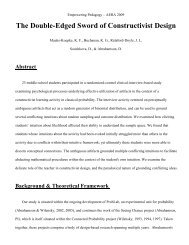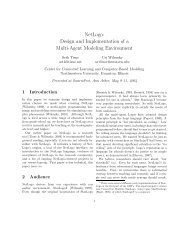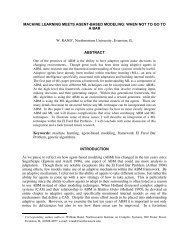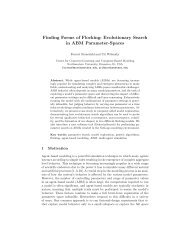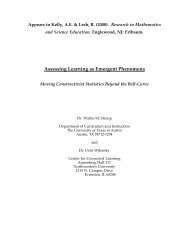Design Guidelines for Agent Based Model Visualization
Design Guidelines for Agent Based Model Visualization
Design Guidelines for Agent Based Model Visualization
Create successful ePaper yourself
Turn your PDF publications into a flip-book with our unique Google optimized e-Paper software.
<strong>Design</strong> <strong>Guidelines</strong> <strong>for</strong> <strong>Agent</strong> <strong>Based</strong> <strong>Model</strong> <strong>Visualization</strong><br />
7.2<br />
7.2<br />
http://jasss.soc.surrey.ac.uk/12/2/1.html<br />
t1 t2 t3<br />
Flocking <strong>Model</strong> with Turtles<br />
Common Fate: These are three frames of an animation. In them you can perceive the groups of Boids<br />
moving together from the top right corner to the bottom left corner. This flocking model (Wilensky<br />
1998f) based on Reynolds classic Boids (Reynolds, 1987) is at<br />
http://ccl.northwestern.edu/netlogo/models/Flocking.<br />
Figure 6. Examples of different perception phenomena in visualizations<br />
Basic Visual Variables: Position, Size, Shape, Color, Orientation & Value<br />
In order to improve a visualization the author needs to critique his or her design. This implies having<br />
a vocabulary to describe his or her visualization and a framework to establish the alternatives <strong>for</strong> a<br />
redesign. This is why visual variables are useful. By providing a common language to deconstruct a<br />
visualization's graphic design, visual variables facilitate communication and the analysis of the<br />
graphical structure of a representation. This analysis can identify problems in a visualization and<br />
reveal plausible design alternatives.<br />
Bertin (1967; 1983) defined the visual variables as position, size, shape, color, orientation, value (i.e.<br />
relative darkness or lightness of a color) and texture. These visual variables can translate directly into<br />
an agent's graphic properties. The table below (see Figure 7) contains an agent-based representation of<br />
Bertin's visual variables. In this table, rows represent the visual variables while columns represent the<br />
agent type: a single turtle, turtles, a single patch, and patches. Note that texture does not have a row as<br />
a separate visual variable, since texture requires multiple agents, it is displayed in the columns labeled<br />
'Turtles' and 'Patches' <strong>for</strong>med by groups of agents.<br />
<strong>Agent</strong> Type<br />
Visual<br />
Variable<br />
Position<br />
Orientation<br />
Value<br />
Turtle Turtles Patch Patches<br />
Does not Apply:<br />
Patches are usually<br />
represented by an<br />
upright square and<br />
polygon<br />
11/20/09 3:30 PM<br />
Page 11 of 32



